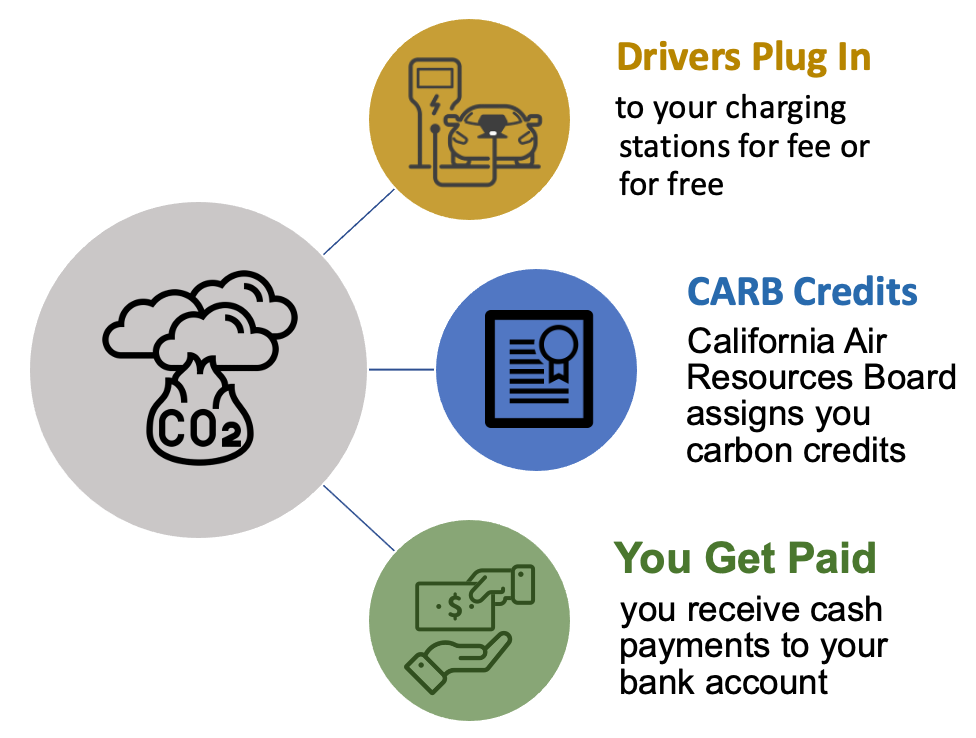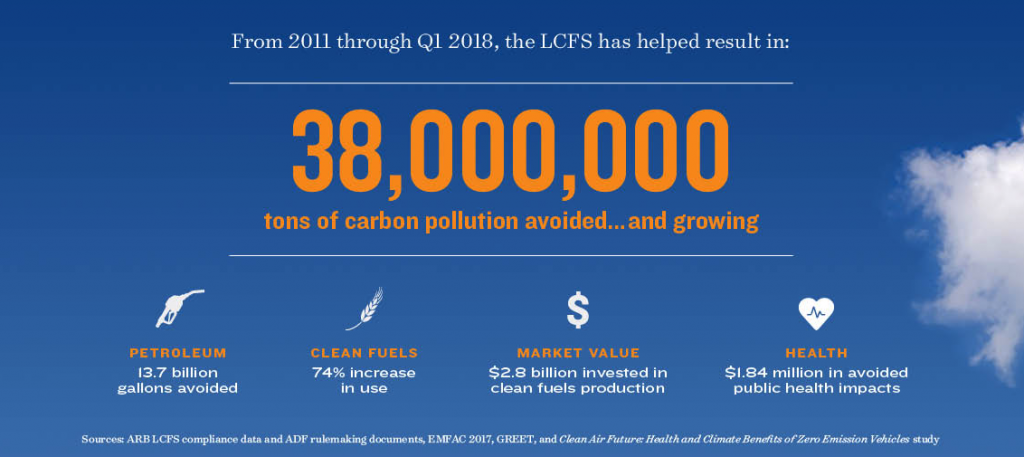(LCFS) Low Carbon Fuel Standard
Plug’n Paid
.
California Regulators mandate that polluters must buy LCFS carbon credits from now till 2030

..
California’s Carbon Credit Program
The California Air Resources Board (CARB) carbon credit program known as the Low Carbon Fuel Standard (LCFS) is a Cap-n-Trade program that directly benefits owners of Electric Vehicle Charging Stations. The best climate policy — environmentally and economically — limits emissions and puts a price on them. Cap and trade is one way to do both. It’s a system designed to reduce pollution in our atmosphere. The cap on greenhouse gas emissions that drive global warming is a firm limit on pollution. The cap gets stricter over time. The trade part is a market for companies to buy and sell allowances that let them emit only a certain amount, as supply and demand set the price. Trading gives companies a strong incentive to save money by cutting emissions in the most cost-effective ways.
.
Caps limit harmful emissions
The government sets the cap across a given industry, or ideally the whole economy. It also decides the penalties for violations. Carbon dioxide and related pollutants that drive global warming are main targets of such caps. Other pollutants that contribute to smog can also be capped. In carbon dioxide’s case, the heat-trapping greenhouse gas mixes into the upper atmosphere and has a global effect. Reducing emissions locally lowers levels around the world.
Companies are allowed to emit set amounts
The total amount of the cap is split into allowances, each permitting a company to emit one ton of emissions. The government distributes the allowances to the companies, either for free or through an auction. The cap typically declines over time, providing a growing incentive for industry and businesses to reduce their emissions more efficiently, while keeping production costs down.
Trading can lead to cuts in pollution sooner
Companies that cut their pollution faster can sell allowances to companies that pollute more, or “bank” them for future use. This market — the “trade” part of cap and trade — gives companies flexibility. It increases the pool of available capital to make reductions, encourages companies to cut pollution faster and rewards innovation.
.

.
.
OVERVIEW
The Low Carbon Fuel Standard is designed to decrease the carbon intensity of California’s transportation fuel pool and provide an increasing range of low-carbon and renewable alternatives, which reduce petroleum dependency and achieve air quality benefits.
A Low Carbon Fuel Standard (LCFS) is a market-based incentive program intended to reduce the carbon intensity of transportation fuels within the state. A LCFS market sets carbon-intensity goals for the transportation sector, which decrease with each respective year. To meet compliance requirements, importers and refiners of carbon-intensive fuels, such as gasoline and diesel, accrue deficits which they need to offset with credits. These entities are required to either blend cleaner fuels or purchase LCFS credits from generators of lower carbon-intensity fuels (i.e. electricity, biofuel, renewable diesel, etc.) to offset their deficits. Each LCFS credit represents one metric ton (MT) of CO2 reduced.
The value of an LCFS credit is determined by supply and demand dynamics within the market. Typically, the market has an auction or credit clearance market in place to set an effective cap on the market and contain costs. In these markets, compliance buyers can carry forward their obligations, accruing interest on their obligations each successive year. As such, these markets do not typically have an alternative compliance penalty (ACP) as in some other environmental commodity markets.
.

LCFS Facts
- 1 LCFS Credit = 1 metric ton (MT) of CO2 equivalent reduced
- Value is determined by market supply and demand mechanics
- Electric vehicle fleets and charging stations must be certified by the appropriate state entity to sell LCFS credits
- GPS manages the registration and credit monetization process
.
LCFS Calculator
The Low Carbon Fuel Standard is designed to decrease the carbon intensity of California’s transportation fuel pool and provide an increasing range of low-carbon and renewable alternatives, which reduce petroleum dependency and achieve air quality benefits. Low Carbon Fuel Standard Homepage
The Low Carbon Fuel Standard (LCFS) is administered by the California Air Resources Board (CARB). Participation requires registration. The LCFS program is set to continue through at least 2030. The calculation below is based on the methodology provided by CARB, which assumes a decreasing carbon intensity of fossil fuels. This formula makes no assumptions about a similar decreasing carbon intensity of the California Grid, therefore it is recommended to use the results of 2021 for a typical year. When using the calculation below (assume a flat LCFS credit price of $195). This value is not guaranteed going forward and changes weekly. See the latest LCFS credit prices and calculator/formula(s) here. A single LCFS credit represents 1 metric ton of carbon, and credit prices are often referred to as $/MT (dollars per metric ton).
.
Resources:
=ROUNDUP { [ (CI_Gasoline (gCO2e/MJ)) – ((2019 CI_Electricity_Grid (gCO2e/MJ)) / ERR) ] * 3600 * (Q Electricity (MWh) Meter Data) * ERR / 1 * 10^-6 , 0 }
.
State of California Code of Regulations: Title 17 Public Health, Division 3 Air Resources, Chapter 1 Air Resources Board, Subchapter 10 Climate Change, Article 4 Regulations to Achieve Greenhouse Gas Emission Reductions, Sub article 7 Low Carbon Fuel Standard, Final Regulation Order
Amended/Adopted sections 95481, 95482, 95483, 95483.1, 95483.2, 95483.3, 95484, 95485, 95486, 95486.1, 95486.2, 95487, 95488, 95488.1, 95488.2, 95488.3, 95488.4, 95488.5, 95488.6, 95488.7, 95488.8, 95488.9, 95488.10, 95489, 95490, 95491, 95491.1, 95492, 94593, 95494, 95495, 95500, 95501, 95502, and 95503
Low Carbon Fuel Standard Annual Updates to Lookup Table Pathways – Feb 2019
California Average Grid Electricity Used as a Transportation Fuel in California AND Electricity Supplied under the Smart Charging or Smart Electrolysis Provision
.
LCFS History
Under the AB 32 Scoping Plan, the Board identified the Low Carbon Fuel Standard (LCFS) as one of the nine discrete early action measures to reduce California’s greenhouse gas (GHG) emissions that cause climate change. The LCFS is a key part of a comprehensive set of programs in California to cut GHG emissions and other smog-forming and toxic air pollutants by improving vehicle technology, reducing fuel consumption, and increasing transportation mobility options. The LCFS is designed to decrease the carbon intensity of California’s transportation fuel pool and provide an increasing range of low-carbon and renewable alternatives, which reduce petroleum dependency and achieve air quality benefits.
The Board approved the LCFS regulation in 2009 and began implementation on January 1, 2011. CARB approved some amendments to the LCFS in December 2011, which were implemented on January 1, 2013. In September 2015, the Board approved the re-adoption of the LCFS, which became effective on January 1, 2016, to address procedural deficiencies in the way the original regulation was adopted. In 2018, the Board approved amendments to the regulation, which included strengthening and smoothing the carbon intensity benchmarks through 2030 in-line with California’s 2030 GHG emission reduction target enacted through SB 32, adding new crediting opportunities to promote zero emission vehicle adoption, alternative jet fuel, carbon capture and sequestration, and advanced technologies to achieve deep decarbonization in the transportation sector.
The LCFS is designed to encourage the use of cleaner low-carbon transportation fuels in California, encourage the production of those fuels, and therefore, reduce GHG emissions and decrease petroleum dependence in the transportation sector. The LCFS standards are expressed in terms of the “carbon intensity” (CI) of gasoline and diesel fuel and their respective substitutes. The program is based on the principle that each fuel has “life cycle” greenhouse gas emissions that include CO2, CH4, N2O, and other GHG contributors. This life cycle assessment examines the GHG emissions associated with the production, transportation, and use of a given fuel. The life cycle assessment includes direct emissions associated with producing, transporting, and using the fuels, as well as significant indirect effects on GHG emissions, such as changes in land use for some biofuels. The carbon intensity scores assessed for each fuel are compared to a declining CI benchmark for each year. Low carbon fuels below the benchmark generate credits, while fuels above the CI benchmark generate deficits. Credits and deficits are denominated in metric tons of GHG emissions. Providers of transportation fuels must demonstrate that the mix of fuels they supply for use in California meets the LCFS carbon intensity standards, or benchmarks, for each annual compliance period. A deficit generator meets its compliance obligation by ensuring that the amount of credits it earns or otherwise acquires from another party is equal to, or greater than, the deficits it has incurred.
Other jurisdictions are joining California, which is evident in the Pacific Coast Collaborative, a regional agreement between California, Oregon, Washington, and British Columbia, to strategically align policies to reduce GHG and promote clean energy. CARB has been routinely working with these jurisdictions, and over time, these LCFS programs will build an integrated West Coast market for low-carbon fuels that will create greater market pull, increased confidence for investors of low carbon alternative fuels, and synergistic implementation and enforcement programs. CARB also continues to engage with representatives from Canada and Brazil as they develop similar clean fuels program.
.
For basic information regarding CARB’s Low Carbon Fuel Standard (LCFS) Program pursuant to
the California Assembly Bill (AB) 32 and the Governor’s Executive Order S-01-07.
.

Helping All Of Us Continue To Navigate Our Way To $avings
More than 30 million cars, trucks and buses traverse California roads, responsible for roughly 40% of the state’s total carbon pollution while contributing to smog and soot particles that pollute the air we breathe.
In 2011, the state began implementing the Low Carbon Fuel Standard (LCFS), which requires the oil industry to gradually reduce the carbon-intensity of gasoline and diesel 10% by 2020 by phasing in lower carbon fuels. In 2018, the California Air Resources Board is considering a proposal to extend the program to a 20% reduction in fuel carbon intensity by 2030, consistent with the state’s groundbreaking climate policy, SB 32. One scientific assessment finds a LCFS of 22% and perhaps as much as 25% is attainable in 2030.
The LCFS is working to transform the fuels market from one that relies almost entirely on petroleum-based fuels to a diversified one that uses a variety of alternative fuels. This market-based transition to clean, low-carbon fuels is leading to technology innovation that’s helping California meet its long term climate, clean air, and public health goals. Just as the state requirements are helping shift our electricity mix to more renewables like wind and solar, the LCFS is also delivering the clean fuels we need today and going forward.
A performance-based standard, the LCFS, doesn’t favor one fuel over another but instead creates incentives for clean fuels. Thanks to the LCFS, the fuels industry now offers lower carbon fuels like advanced biodiesel and renewable diesel produced from waste oils, biogas captured from landfills and dairies, electricity and hydrogen for electric-drive vehicles, and advanced ethanol. In fact, fuel producers have already dramatically lowered their carbon intensities since 2011 while increasing the use of clean alternative fuels by 74%.
IT’S WORKING
Expanding clean fuel options gives California drivers, including transit agencies, more environmentally preferable choices for running their vehicles. Producing lower carbon fuels also leads to more technology-driven, good jobs in the state.
Thus far, the state’s LCFS program has avoided millions of tons of carbon pollution and more than $1.84 million in negative public health impacts. These benefits will continue to accrue and grow as the standard is fully phased-in. According to the Air Resources Board’s latest quarterly compliance report tracking industry performance, the LCFS has produced these benefits.
HEALTH
An analysis of data from a study by the American Lung Association in California finds that, together with California’s other climate policies, the LCFS has helped the state avoid $1.84 million in public health impacts and avert more than 200 premature deaths. Health benefits from these programs will continue to grow as the use of cleaner fuels and cleaner vehicles increases due to these programs.
CARBON POLLUTION AND PETROLEUM DEPENDENCY
Since 2011, the LCFS has helped to slash 38 million tons of carbon pollution through use of lower carbon fuels. As a result, California has avoided 13.7 billion gallons of petroleum. The LCFS is among the largest pollution reduction measures under California’s climate program. Increasing the use of low-carbon fuels is one of the primary strategies to meet California’s 2030 and 2050 carbon and petroleum reduction targets.
INDUSTRY PERFORMANCE
To date, industry has met or exceeded the Low Carbon Fuel Standard’s targets. The program has helped increase the value of the clean fuels market — including investments in production and distribution — by an estimated $2.8 billion since 2011. While this is still only a fraction of the hundreds of billions spent over the same time period on petroleum-based fuels in California, the LCFS is jumpstarting increased investments across the clean fuel supply chain.

